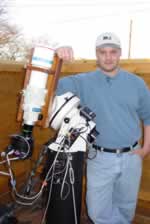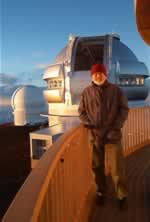
A Gemini Multi-Object Spectrograph image of McNeil's Nebula obtained on Feb 14th at 05:56 UT on the Frederick C. Gillett Gemini Telescope on Mauna Kea, Hawaii. Three one-minute exposures in 0.5 arcsec seeing with three different filters (g, r, and i) were combined to make this color composite image. Additional images of this nebula are planned at Gemini, as well as ongoing spectral studies of the light streaming from the newly forming star at the base of the nebula. This image was obtained at Gemini Observatory by Colin Aspin and processed into a color composite by Kirk Pu'uohau-Pummill (Gemini Observatory) and Travis Rector (University of Alaska, Anchorage). Credit: Gemini Observatory Image |
|
Click on image for hi-resolution TIFF (1.8MB) |
This series of illustrations shows what astronomers think might be occurring around the young star at the apex of McNeil's Nebula. The star illuminates a cone-shaped outflow cavity in the existing cloud. All artwork by Jon Lomberg, credit: Gemini Observatory Illustrations |
|
|
|
| Figure 1 shows the young star at a quiescent stage early in the birth process. It is surrounded by a circumstellar disk and a shroud of gas and dust. Very little of the star's optical light can escape, so it shines primarily in the infrared part of the spectrum. | |
|
|
|
|
Figure 2 illustrates the beginning of the latest eruption. Gas rotating through inner regions of the disk begins to heat up and glow. At the same time, some gas is caught on magnetic field lines and is lifted out of the disk. Then it falls onto the star where it creates one or more hot spots. |
|
|
|
| Figure 3 shows the eruption at a later stage when the luminous inner
disk and the blinding white hot spots produce more light than the star.
Gemini spectroscopic observations reveal that gas escapes from the
erupting star-disk system with velocities of more than 600 km/second.
This is one of the fastest winds ever recorded around a young star.
The outflow clears away some of the surrounding gas and dust that
shrouds the embryonic star, allowing the visible light from the star to
shine through. |
|
|
|
|
| Figure 4 shows a more distant view of the system, and depicts how light from the brightened star and disk illuminate the surrounding outflow cavity. This is what we see as McNeil's Nebula. | |
|
|
|
| Figure 5 shows the approximate location of McNeil's Nebula near the well-known reflection nebula called M78. Located above the three stars that form the belt of Orion, McNeil's Nebula can be viewed in a small telescope from nearly any location on Earth until this part of the sky is obscured by the glare of the Sun for several months between late April and late August.
|
|
 High-resolution JPEG (1.5 MB ) |
Kentucky amateur astronomer Jay McNeil, discoverer of McNeil's Nebula, standing next to the 3" telescope he used to make the discovery.
|
 Medium-resolution JPEG (147 KB) |
IInstitute for Astronomy astronomer Dr. Bo Reipurth stands on the catwalk of the University of Hawaii's 88-inch (2.2-meter) telescope overlooking the Frederick C. Gillett Gemini Telescope on Mauna Kea. Dr. Reipurth has served as staff astronomer at the European Southern Observatory, the Center for Astrophysics and Space Astronomy at the University of Colorado, and came to the University of Hawaii to study star and planet formation. |
 High-resolution JPEG (265 KB) |
Gemini Astronomer Dr. Colin Aspin at the Gemini headquarters in Hilo, Hawaii. Dr. Aspin has been a Gemini observatory scientist since 2001. Over the course of his career, he has served as senior staff astronomer at the Nordic Optical Telescope (NOT) on La Palma, Canary Islands, as a scientific officer at the United Kingdom's Infrared Telescope on Mauna Kea, and as a research fellow at the Royal Observatory, Edinburgh, Scotland. His research centers on characterizing star formation in various environments. |
|
|
|